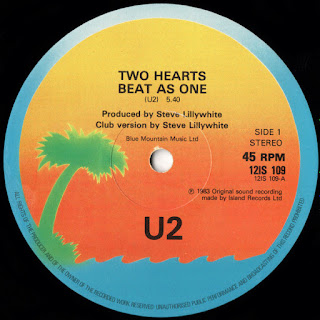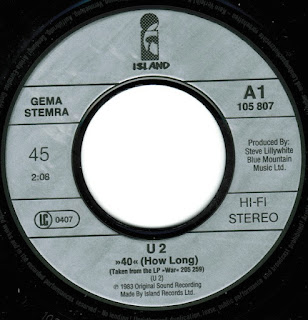U2 - TWO HEARTS BEAT AS ONE / 40
TWO HEARTS BEAT AS ONE
Estrena: 21 de març de 1983
Llistes: EUA: #101 Regne Unit: #18
"Two Hearts Beat as One" és la setena pista de l'àlbum "War" i va ser el segon single del disc. Coneguda per la línia de baix d'Adam Clayton, que va introduir un ritme profund i inesperadament ballable, la cançó està ben construïda com a peça pop. Es va publicar un remix dance de Steve Lillywhite com a maxi single.
Bono va començar a escriure la cançó durant la seva lluna de mel al Carib amb la seva dona Alison Stewart, amb qui havia estat sortint des de 1975 i es van casar el 21 d'agost de 1982 a Irlanda. Malgrat l'expectativa habitual de no treballar durant la lluna de mel, Bono es va inspirar per escriure sobre el tema de dues persones que es troben. Es va imaginar la cançó com una peça que artistes com Aretha Franklin o Barbra Streisand podrien interpretar.
"Two Hearts Beat as One" va debutar en concert el 26 de febrer de 1983, durant el primer espectacle de la gira de War. Es va convertir en part habitual del seu repertori per gairebé tots els concerts d'aquella gira. Durant la segona etapa de la gira de War, sovint es tocava després de "Surrender", i les dues cançons es barrejaven de manera fluida. Una interpretació en directe al Red Rocks Amphitheatre apareix al DVD del film del concert "Live at Red Rocks: Under a Blood Red Sky".
El vídeo musical va ser dirigit per Meiert Avis i filmat al març de 1983 a l'exterior de la Basílica del Sagrat Cor de Montmartre a París. El vídeo mostra la banda interpretant la cançó, intercalat amb escenes d'un acròbata i plans de Peter Rowen, el noi que apareix a la portada de l'àlbum.
40
Estrena: agost de 1983
Àlbum: War
"40", coneguda també com a "40 (How Long)", és la darrera pista de l'àlbum "War". És coneguda per les seves actuacions en directe, durant les quals el guitarrista The Edge i el baixista Adam Clayton intercanvien instruments. Les lletres estan adaptades del Salme 40 de la Bíblia. "40" va ser llançada comercialment com a single només a Alemanya, principalment per promocionar l'actuació de la banda al Festival de Loreley el 1983. El single es va publicar amb "40" com a cara A i la versió de l'àlbum de "Two Hearts Beat as One" com a cara B.
Aquesta melodia té un origen fascinant, sorgida de l'agenda ajustada d'estudi de la banda i la decisió espontània de Bono de basar les lletres en el Salme 40. Malgrat els seus orígens bíblics, la cançó permet l'espai per a la interpretació personal. La frase final fa eco d'un sentiment de "Sunday Bloody Sunday", connectant temàticament l'inici i el final de l'àlbum.
"40" ocupa un lloc especial en les actuacions en directe d'U2, sovint com a cançó de tancament durant els seus concerts dels anys 1980, on els membres de la banda anaven deixant progressivament l'escenari mentre el públic cantava la tornada "How long to sing this song?". Es convertia en un moment emotiu on els fans de tots els orígens es reunien, agafant-se de les mans i cantant amb passió.
U2 - TWO HEARTS BEAT AS ONE / 40
TWO HEARTS BEAT AS ONE
Released: March 21, 1983
Charted: US: #101 UK: #18
"Two Hearts Beat as One" is the seventh track on the 1983 album "War" and served as its second single release. Known for Adam Clayton's bassline, which introduced a deep and unexpectedly danceable rhythm, the song is well-constructed as a pop piece. A dance remix by Steve Lillywhite was released as a 12”.
Bono started writing the song during his honeymoon in the Caribbean with his wife Alison Stewart, whom he had been dating since 1975 and married on August 21, 1982, in Ireland. Despite the typical expectation of not working during a honeymoon, Bono was inspired to write about the theme of two people coming together. He envisioned the song as something that artists like Aretha Franklin or Barbra Streisand might cover.
"Two Hearts Beat as One" made its concert debut on February 26, 1983, during the first show of the War Tour. It became a regular part of their setlist for nearly all concerts on that tour. During the second leg of the War Tour, was often played following "Surrender," and the two songs were seamlessly merged together in performances. A live performance of the song at Red Rocks Amphitheatre was captured and appears on the DVD release of the concert film "Live at Red Rocks: Under a Blood Red Sky."
The music video for was directed by Meiert Avis and filmed in March 1983 outside the Basilica of Sacré-Cœur de Montmartre in Paris. The video features the band performing the song, interspersed with scenes of an acrobat and shots of Peter Rowen, the boy who appears on the album cover.
40
Released: August 1983
Album: War
"40", also known as "40 (How Long)", is the closing track on 1983 album "War". It's renowned for its live performances, during which guitarist the Edge and bassist Adam Clayton switch instruments. The song's lyrics are adapted from Psalm 40 in the Bible. "40" was commercially released as a single only in Germany, primarily to promote the band's performance at the Loreley Festival in 1983. The single was issued on a 7-inch gramophone record format, featuring "40" as the A-side and the album version of "Two Hearts Beat as One" as the B-side.
This tune has a fascinating genesis, born out of the band's tight studio schedule and Bono's spontaneous decision to base the lyrics on Psalm 40. The song, despite its biblical origins, allows room for personal interpretation. The closing line echoes a sentiment from "Sunday Bloody Sunday," linking the album's beginning and end thematically.
"40" holds a special place in U2's live performances, often serving as the closing song during their concerts in the 1980s where the band members would gradually leave the stage as the audience sang the refrain "How long to sing this song?". It became a poignant moment where fans of all backgrounds would join together, holding hands and singing along passionately to the chorus.














Cap comentari:
Publica un comentari a l'entrada